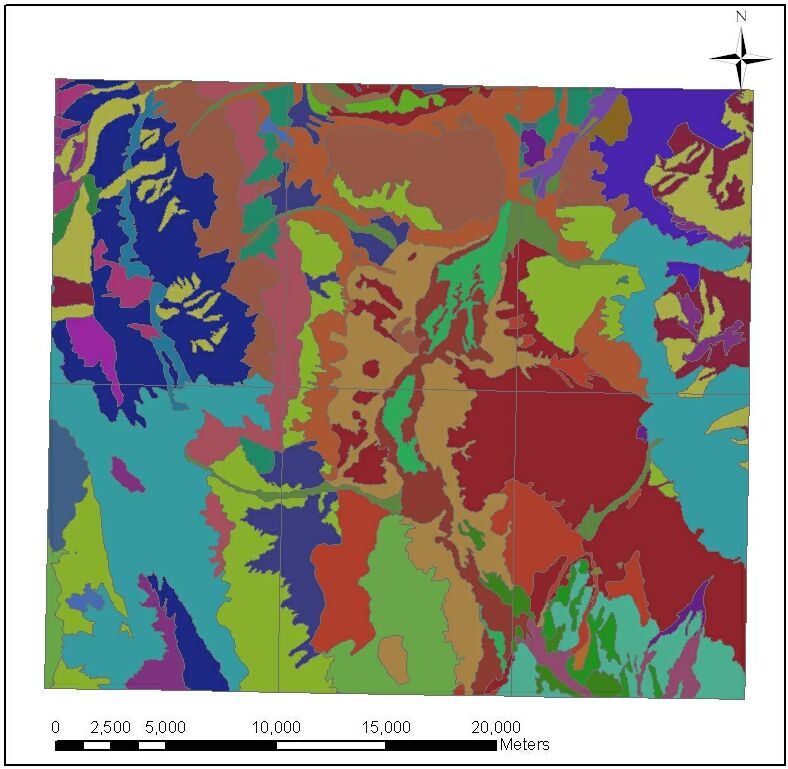Fall Semester, 2001. August 28 - December 6.
Term Paper:
Assessing Soil Water Infiltrability for Different Rainfall Intensities - Rush Valley, UT
Vasile Turcu
Department of Plants, Soils and Biometeorology - Utah
State University
Introduction
Water ressources
management is an important issue of our days, and especially in arid and
semi-arid regions, where a better estimation of water balance in soil is
crucial. One important issue is to evaluate qualitatively and quantitatively
the spatial distribution of water in the region of interest. The input
is generally the precipitation, but we need better tools to evaluate how
water redistributes itself whithin the soil surface. Soil infiltration
models are one way of dealing with this issue.
Objectives
In order to evaluate the infiltration rates for water infiltration in different types of soils, the Lewis-Kostiakov equation was used:
,
Data used and procedure
Soil data in digital format for the area was downloaded from the United States Geological Survey (USGS) web site. Data is organized in 7.5 quadrangles an can be added as map layer in ArcView. For the area of interest, 6 quadrangles were used (coded in USGS classification as S4011236, S4011237, S4011238_0a, S4011244_0a, S4011245_0a, and S4011246_0a).

Data characteristics are as follows:
Grid_Coordinate_System_Name:
Universal Transverse Mercator
Universal_Transverse_Mercator:
UTM_Zone_Number:
11
Transverse_Mercator:
Scale_Factor_at_Central_Meridian: 0.9996
Longitude_of_Central_Meridian: -117.0
Latitude_of_Projection_Origin: 0.0
False_Easting: 500000
False_Northing: 0.0
Universal_Transverse_Mercator:
UTM_Zone_Number:
12
Transverse_Mercator:
Scale_Factor_at_Central_Meridian: 0.9996
Longitude_of_Central_Meridian: -111.0
Latitude_of_Projection_Origin: 0.0
False_Easting: 500000
False_Northing: 0.0
Planar_Coordinate_Information:
Planar_Coordinate_Encoding_Method:
coordinate pair
Coordinate_Representation:
Abscissa_Resolution:
0.61
Ordinate_Resolution:
0.61
Planar_Distance_Units: meters
Geodetic_Model:
Horizontal_Datum_Name: North American
Datum of 1927
Ellipsoid_Name: Clarke 1866
Semi-major_Axis: 6378206.4
Denominator_of_Flattening_Ratio: 294.98
The layers were merged into a single one, called RV.lyr.
In the attribute table, the last field is MUSYM, which is a symbol
that uniquely identifies a map unit within a soil survey area. According
to this last field classification of the area, a new field called INF (from
infiltration) was added. This field contains values of infiltration rates
calculated primarly in Excel for each type of soil, using the model described
above. Based on this field, a new delineation could be done in ArcView,
considering the areas where rainfall intensity (assumed constant) overcomes
infiltration rate as regions with runoff.
The scenario includes the hypothesis of three different rainfall events:
1. Intensity: 1 mm/h; time: 2 h;
2. Intensity: 5 mm/h; time: 2h;
3. Intensity: 5 mm/h; time: 4h.
(Rainfall intensities are assumed constant in time.)
Calculations of Lewis-Kostiakov model parameters and of infiltration
rates were done in Microsoft Excel:
Results and discussion
For the first case, a raifall event with intensity of 1mm/h and a duration
of 2 hours, calculated potential infiltration rate is in between 40 to
75 mm/h (really high!) so all water from precipitation infiltrates in soil,
no matter of the soil type. No runoff occurs in this situation.
The second simulation was done for a rainfall intensity of 5 mm/h,
during a 2 hours period. In this case, calculated infiltrability ranges
from 7.5 to 13 mm/h.
Regions in blue, are the regions where there is runoff: a) for 2 hours
and b) for 4 hours.
One can see the expected extension of surfaces where runoff occurs.
Next steps for future work could be to evaluate it quantitatively and integrate
the total volume of water that accumulates from one region with runoff
to its adjacent regions. This will be important for the global and local
water balance in soil, as well for calculating soil water availability
for plants. As more data is available, the model shoud be improved and
take into account evapotranspiration, land coverage, slope, etc.
Conclusions
References
- Or D., and Wraith, J.M., 1994. Agricultural and Environmental
Soil Physics (classnotes).
- Zeiler, M., 1999. Modeling Our World - ESRI Press.